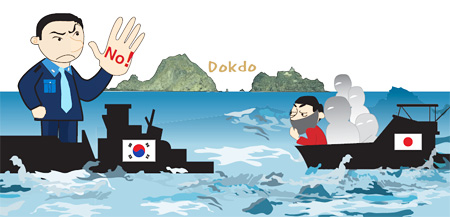‘Samurai warriors’ coming to Dokdo!
This and other scenarios may not be as remote as once thought
What if Japan’s “samurai warriors” tried to land on Dokdo?
Japanese ultra right-wing nationalists have already landed on internationally disputed islands.
At a time when Tokyo is trying to dispute Seoul’s sovereignty over Dokdo, the possibility can’t be ruled out.
As things stand now, however, Korea has advantages to prevent such an attempt but complacency is the last thing that it can afford.
Besides, Japan’s tradition of “Kamikaze” suicide pilots during World War II and its assassins’ murder of Queen Min of the Joseon Kingdom calls for a full alert to such a contingency.
Many experts claim that Korea’s rocky islets in the East Sea are an impenetrable fortress capable of resisting any unsolicited intruder with the Coast Guard and Armed Forces providing around-the-clock surveillance.
However, they stress the need to prepare for the worst-case scenario of an armed clash.
Scenario 1: Disguised as tourists
One of the most plausible scenarios for an illegal entry is Japanese extremist activists or politicians setting foot on Dokdo by disguising themselves as tourists in an attempt to stage an offensive rally without permission.
In fact, legitimate foreign visitors, including Japanese, are allowed to tour Dokdo by simply taking a ferry from Ulleung Island, which is located just 90 kilometers from the scenic islets.
Ulleung islanders say those affiliated with extremist civic groups in Japan can be banned from traveling to Dokdo under an ordinance by Ulleung County, but the screening process is not rigid.
Navy officials, however, claim that it is unlikely that far-right Japanese activists or politicians would secretly land on Dokdo to hold a rally there in protest of Korea’s sovereignty of the rocky outcrops.
“Activists belong to Japan’s right-wing groups will not stealthy land on Dokdo as what they want is to make it disputed territory,” a Navy spokesman said asking for anonymity.
He noted that it was more likely they would stage rallies in Japan to criticize Korea’s control of Dokdo to draw media attention before announcing a planned visit to the East Sea islets.
If so they will be treated no different to three hardline Japanese lawmakers who were sent back home upon their arrival at a Korean airport for having openly insisted on visiting Dokdo to protest Korea’s sovereignty.
Scenario 2: Helicopter access
Another conceivable scenario is an attempt to land on Dokdo using a helicopter.
A helipad, located at the rocky top, is capable of accommodating a large-size helicopter.
Nevertheless, Lee Kwang-sub, the senior inspector of Dokdo Police Guard, claims that it is impossible for any unauthorized helicopter to land on the pad.
“There are a set of measures in place to reject any unsolicited landing on the helipad,” he said.
A senior Marine official, who has taken part in Dokdo landing drills, concurred with him, saying placing a tripod or any large obstacle on the helipad can deter an illegal landing by a helicopter.
“Japanese may hover around the islets, but will never succeed in landing because a coast guard unit is stationed and reinforcements will arrive immediately,” he said.
“If Japan attempts to illegally occupy Dokdo, a company of the Marines will be dispatched to the islets by UH-60 Black Hawk and CH-47 Chinook helicopters.”
However, Shin In-kyun, head of the defense think tank, Korea Defense Network (KDN), expressed concerns over the possibility of Japan mobilization of an attack helicopter.
“If Japan sends one of its AH-64 Apache helicopters, the entire coast guard unit will be annihilated, allowing Japanese troops to seize Dokdo,” he said.
He noted that Korea does not have a helicopter that is a match to the Apache helicopter and all of its military choppers, such as AH1S Cobras, are incapable of carrying out a mission on Dokdo due to limited flight range and other shortcomings.
Korea plans to sign a deal to purchase 36 attack helicopters, possibly the latest version of the Apache attack helicopter from Boeing, by the end of the year with the aim of deploying them from 2015.
Scenario 3: Armed attack
Shin argues that the worst case scenario would be a clash between a patrol vessel of the Korean Coast Guard and a ship of Japanese protesters who have illegally crossed the maritime border.
“We cannot rule out the possibility that rightwing groups in Japan intentionally attempt to provoke a military conflict,” he said.
He noted that a reckless attempt to land on Dokdo may trigger an armed conflict.
He said the civilian vessel could be damaged or even sunk if a Coast Guard 3,000-ton patrol vessel blocks it.
“Even when the tides are low, it is difficult for a 3,000-ton ship to block a small vessel without inflicting damage,” he said.
“The Japanese Coast Guard, which also operates a 3,000-ton patrol vessel near Dokdo, may interpret the sinking of a right-wing group’s ship as an armed clash.”
He said the patrol vessels of the two countries, both equipped with 40-mm guns, can inflict serious damage on each other and may lead to a bigger armed conflict.
“Unlike warships, patrol ships of the Coast Guard cannot withstand heavy attacks,” he said.
Shin said the destruction of patrol ships may result in a naval war between the two neighboring countries, in which politicians find little room to make compromise over territorial issues.
He said both the people in Korea and Japan may support the idea of their military forces waging a fierce battle in the East Sea on the assumption that such an armed conflict would not escalate to a full-scale war.
“If the battle takes place far away from the mainland, people do not consider it as a serious security threat,” he said.
“The two countries may wage a naval war on a tacit agreement to confine the armed conflict to the territorial issue of Dokdo.” <The Korea Times/Lee Tae-hoon, Chung Min-uck>



